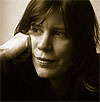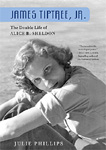August Pick Reveals the Double Life of Alice B. Sheldon
 Julie Phillips |
In the early 1990s, when journalist Julie Phillips began research for a magazine article about the Tiptree Award, she wasn't a science fiction fan and had never heard of the writers James Tiptree, Jr. or Racoona Sheldon. Nor had she heard of Alice B. Sheldon, the woman behind both pseudonyms. Phillips certainly had no idea that she would spend the next 10 years writing James Tiptree, Jr., The Double Life of Alice B. Sheldon (St. Martin's), a richly detailed biography of one of the most fascinating and influential women ever to work in science fiction.
Phillips' first clue to the story behind the name came from the award itself: The James Tiptree, Jr. Award was created in 1991 by Pat Murphy (The City, Not Long After) and Karen Joy Fowler (The Jane Austen Book Club) as an annual prize to recognize "science fiction or fantasy that expands or explores our understanding of gender."
 Alice Sheldon's story is captivating even without the late addition of a doppelganger science fiction writer. Born in 1915 in Chicago, she made her society debut on December 20, 1934, and, on December 28, eloped and married the man she sat next to that Christmas Eve. Divorced by 1941, she became a photoanalyst at the Pentagon for the Women's Army Auxiliary Corps. In 1945, the Army sent Alice to Europe where she met and married Colonel Huntington "Ting" Sheldon. Postwar, Alice worked for the CIA, was a chicken farmer and an artist, earned a Ph.D. in research psychology, and always wrote.
Alice Sheldon's story is captivating even without the late addition of a doppelganger science fiction writer. Born in 1915 in Chicago, she made her society debut on December 20, 1934, and, on December 28, eloped and married the man she sat next to that Christmas Eve. Divorced by 1941, she became a photoanalyst at the Pentagon for the Women's Army Auxiliary Corps. In 1945, the Army sent Alice to Europe where she met and married Colonel Huntington "Ting" Sheldon. Postwar, Alice worked for the CIA, was a chicken farmer and an artist, earned a Ph.D. in research psychology, and always wrote.
Alice's mother was Mary Hastings Bradley, a writer of fiction and travel books, and the young Alice's illustrations are included in two of her mother's books, On the Gorilla Trail and Alice in Jungleland.
In addition to Tiptree (which Alice said came from a jar of English jam) and Racoona Sheldon, at different times of her life Alice was known as Alice Hastings Bradley, Alice Bradley, Alice Davey, Ann Terry, and Mrs. H.D. Sheldon.
Although Alice published a story in The New Yorker in 1946, it wasn't until the late '60s that she began publishing stories regularly in science fiction magazines. Her first was "Birth of a Salesman," published in March 1968 in the digest magazine Analog. Tiptree's stories soon caught the science fiction community's attention. Tiptree's voice was authoritative, knowledgeable, and unsurprised by things going wrong. The stories were dark but lined with a bleak humor, they pulled no punches, and they were most definitely not like anything else being written. Under her pseudonyms, Alice received two Hugos, three Nebulas, two Locus Awards, two Seiun Awards, two Hayakawa Awards, and a World Fantasy Award.
Because Alice turned down invitations to conventions and other social events, speculation on Tiptree's identity was rife for a decade. Her Virginia address and some of her stories that showed a knowledge of "the company" made some readers suspect Tiptree might be someone high up in the CIA. Alice's outing as Tiptree was a bombshell among the science fiction readership that still reverberates today, as evidenced by the Tiptree Award and convention topics such as the influence of gender on the writer and the reader.
Alice was a prolific letter writer and throughout the biography, Phillips uses "Tiptree" and "he" for her letter-writing persona to reflect the experience of Tiptree's original readers. Alice kept carbon copies of most of her letters, in the beginning because they were business, and later because she wanted to keep records of what she had said to each correspondent. Phillips said Alice took letter writing very seriously. As Tiptree, Alice once wrote that she had "a conceited streak about epistolation; I don't get out-epistolated too often."
Tiptree's letters are punchy and opinionated, engaging and questioning, and make it clear why so many writers (including Phillips herself) were drawn under Tiptree's spell. Phillips said Alice loved to search out other intense, witty and sophisticated letter writers. One writer who kept up with Alice was Ursula K. Le Guin. Phillips edited a small selection of these letters for the September issue of The Magazine of Fantasy & Science Fiction. "It starts with Tiptree writing Le Guin a fan letter," Phillips said, "and ends with Alice revealing her identity. Le Guin has just as strong a writing voice as Alli, and more range, and, if possible, is even funnier."
For some years, the last act of Alice's life almost eclipsed her writing. She had long been depressed both by her and her husband's slowly declining health and the political state of the world. She talked for years of suicide (her note was written in 1979) and in May 1987, although both of them were still relatively healthy, she shot first her husband, then herself.
Phillips does not let Alice's sad, early death get in the way of her subject, however. In James Tiptree, Jr., The Double Life of Alice B. Sheldon, she lets Alice be herself as it seems she was never able to be during her life. --Gavin J. Grant